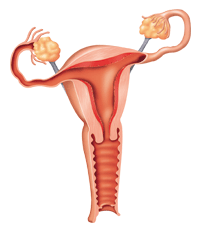The female genital tract consists of the ovaries (which contain the egg cells and cells which produce hormones such as oestrogen and progesterone); the fallopian tubes (which provide a pathway for the egg between the ovary and the uterus, and where fertilisation usually occurs); the uterus, or womb (designed for the development of the foetus); the vagina (via which, under normal circumstances, sperm is introduced during intercourse to fertilise the egg, and via which the baby is born), and the vulva, which constitutes what’s called the “external genitalia” - the only part visible to most of us - consisting of two thin folds of skin called the labia minora, and two thicker, outer, hair-bearing folds called the labia majora. The clitoris is a button of tissue which sits at the apex of the vulva, where the labia minora join together, which becomes erect due to increased blood flow during sexual arousal, and is analogous to the male penis. The bottom of the vulva is separated from the anus by a firm block of tissue called the perineal body. The whole of the area between this at the bottom and the clitoris at the top is called the perineum (because it’s this which is around the baby - or neonate - at birth). The Vulva consists of the fleshy hair-bearing labia majora which run from the pubic mound to the perineal body, which sits just in front of the anus. Behind these lie two soft lips of flesh - the labia minora - which together at the top form the covering of the clitoris, and at the bottom meet to form what is called the fourchette. Between the labia majora and minora, on each side, are glands called Bartholin’s glands. These produce secretions which act as pheromones, or sexual attractants. In the virgin there is a thin fold of skin - the hymen - which covers the entrance to the vagina, and has an opening in the middle to allow the flow of menstrual blood. | |||
 | This information is licensed for use by Wellbeing Information Systems Ltd ("WIS"), and protected by international copyright law. All rights are reserved. (email info@wisinfo.co.uk). |
